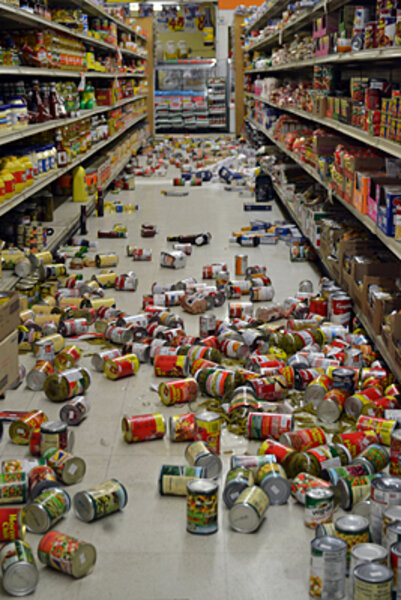Earthquake 'swarm' in southern California: nuisance or threat?
Loading...
A so-called "swarm" of earthquakes jiggling Southern California this week poses a relatively small threat to humans but does pose something of a geologic mystery.
Starting on Sunday, hundreds of earthquakes have shaken Imperial County, a rural area east of San Diego. Most have been minor, but some have been felt in surrounding counties and have clocked in as high as magnitude 5.5 and 5.3.
In the small city of Brawley, where the quakes are centered, they have damaged windows, knocked goods off store shelves, and bounced trailer homes off their foundations.
Why is this happening, and could the swarm be a precursor of the "Big One"?
Seismologists are confident the answer to the second question is "no." They say the quakes around Brawley may continue for several days, but judging from history, such swarms are not predictive of larger temblors along two major geologic fault lines in Southern California – the San Andreas and Imperial faults.
As to what caused this week's swarm, researchers say it has to do with the region's distinctive geology.
"Compared to the rest of California, it's thinner crust, and hotter, and [has] more fluids," says Lucy Jones, a seismologist at the US Geological Survey in Pasadena, Calif. She describes the imperial Valley as "one big bowl of sediment."
"Those would likely be reasons that contribute to this," Ms. Jones says. "But we don't yet have the details of the physics."
The earth's thin crust in the region, and the proximity of hot magma beneath it, relates to the Imperial Valley's location at the top end of a fault in which tectonic plates are moving apart from one another to form the Gulf of California. The Brawley area, 100 miles east of San Diego, is "like the very end of a ridge that's trying to spread open. It's actually probably giving up on spreading open," Jones says.
When earthquakes make news, the event is more commonly a major quake followed by smaller aftershocks.
In the Brawley area, what are occurring instead are multiple events per hour. Such swarms are more often linked to active volcanoes than places like Southern California with little volcanic activity.
"There's potential for more in the Imperial Valley" this week, Jones says. Monday has been a quieter day, but still has seen quakes at a rate of several per hour.
It's significant, Jones says, that the Brawley zone has no big fault. For an earthquake to reach magnitude 7, a fault must be at least 50 kilometers long.
While not having large faults, the city is wedged fairly close to the Imperial Fault (where magnitude 7 quakes have occurred) and to the southern end the San Andreas Fault. Both those are "transform faults," where tectonic plates essentially slide along each other horizontally.
"The ability of an earthquake to trigger other earthquakes dies off with distance quite quickly," Jones says. The larger faults are far enough away from Brawley that, amid past quake swarms there, "we've never seen them followed by San Andreas activity."
Translation: This week's swarm, although felt sometimes in coastal population centers, appears to have few implications for the rest of California.
It is significant, however, for residents of the Imperial Valley, a desert region with irrigation-centered agriculture. The shaking Sunday put many residents on edge, and some 20 mobile homes at a trailer park were pushed off their foundations, the Associated Press reported.
The swarm also serves as a reminder, in California and elsewhere, that people be prepared for emergencies including quakes. The Southern California Earthquake Center offers a seven-step guide to preparedness on its "earthquake country" website.








